Honor Your Ancestors with These Dia de Los Muertos Rituals

"Hearst Magazines and Yahoo may earn commission or revenue on some items through the links below."
Dia de Los Muertos, which spans from November 1 to November 2, is a time to connect with ancestors. The holiday is celebrated throughout Latin America and especially in Mexico, where the tradition originates, and is effectively a fusion between indigenous Aztec beliefs and Catholic influences.
Despite the name, Dia de Los Muertos—also known as Day of the Dead—is not only about the dead, but the living. The holiday’s celebrations are intended to build a bridge between the living and the dead, through the act of remembering those who came before us. Traditions include gathering at cemeteries, creating ofrendas (altars), laying out marigold floral arrangements, making cavaleras (edible skulls made of sugar), eating a bread known as pan de muerto, and decorating with La Catrina, the recognizable image of a lithe skeleton, normally wearing a hat and a colorful dress.
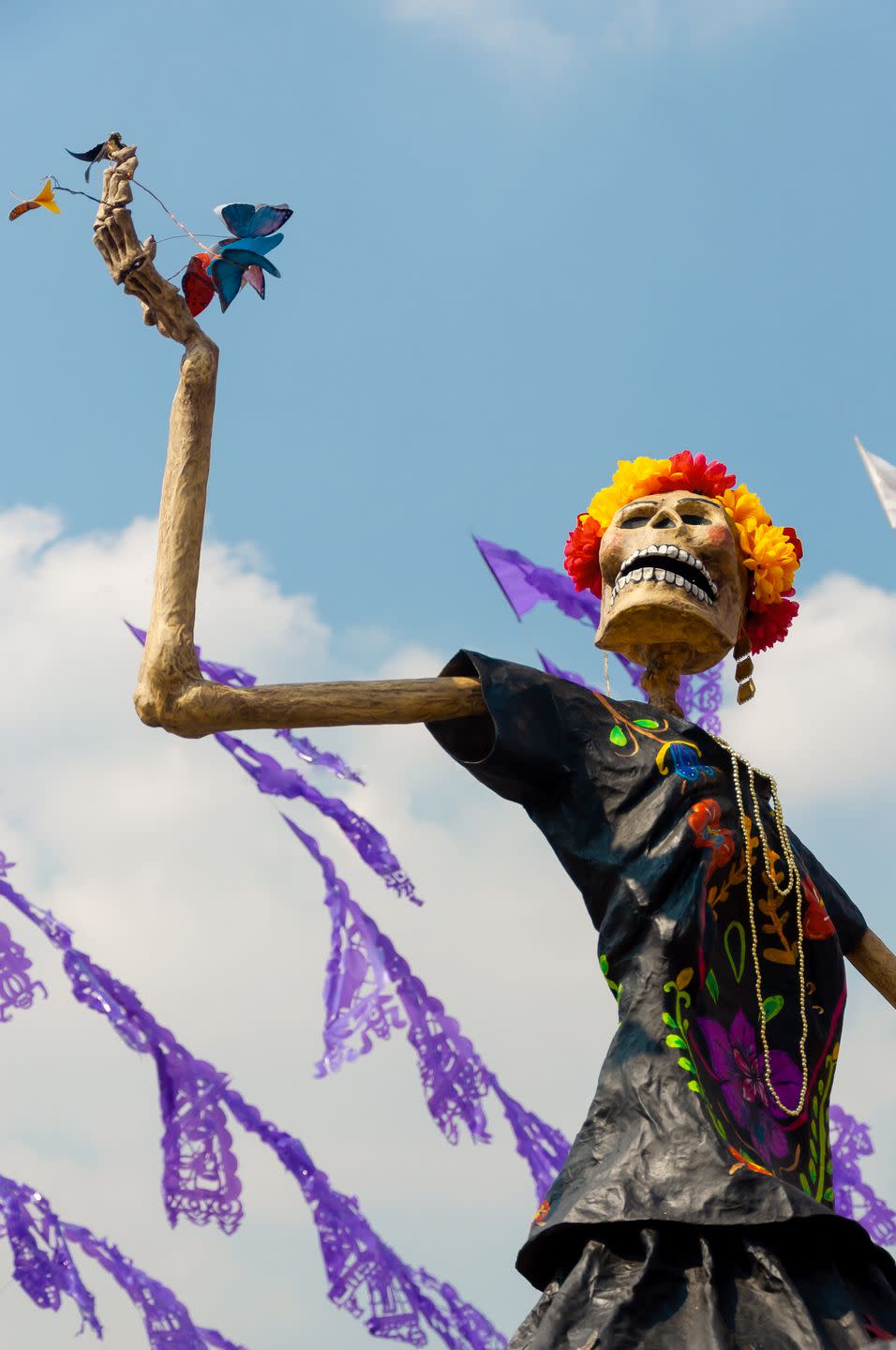
La Catrina (whose official name, "La Calavera Catrina," translates to "the elegant skeleton") originated in satirical cartoons by Mexican illustrator Jose Guadalupe Posada, whose art poked fun at the social unrest and hypocrisy in the country in the 1910s. Posada was inspired by Mictecacihuatl, the skull-headed Aztec goddess of death, when designing his influential (and skeletal) figurines. One such figure—now wearing a dress and hat—was at the center of Diego Rivera's 1947 mural, "Dream of a Sunday Afternoon in Alameda Park." And so, an enduring image was born, in conversation with ancient tradition and modern-day sensibilities like the holiday itself.
Oaxaca City-based curandera Rocky Seker says that the city comes together during the multi-day holiday to create an astonishing spectacle. While the holiday is celebrated throughout Mexico, Oaxaca is considered the epicenter of the festivities.
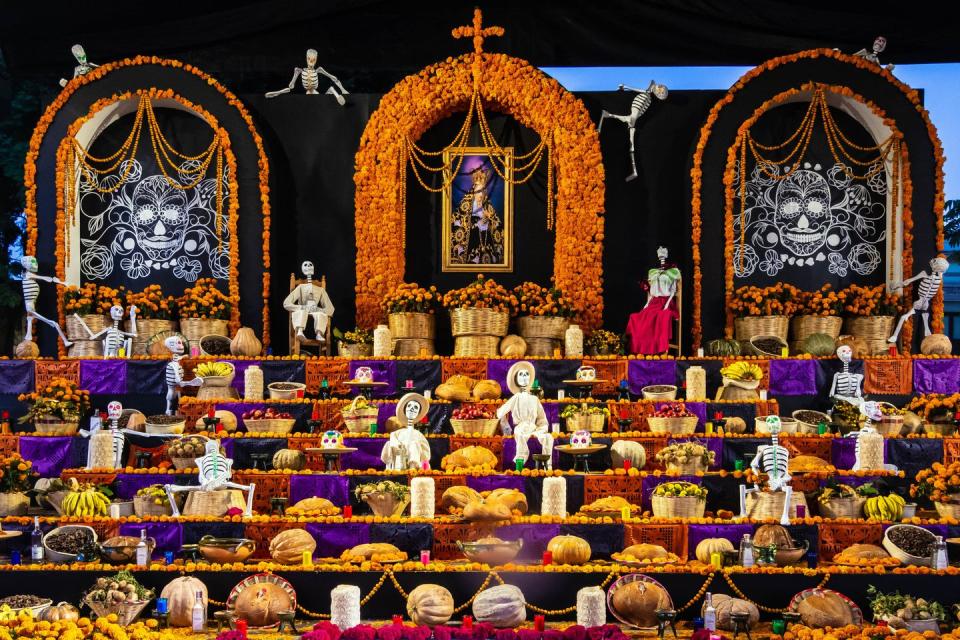
"The community builds huge altars with beautifully dressed skeletons in traditional clothing, flowers, food offerings, and candles, as well as pictures of ancestors, relatives, famous Mexican figures, and of course Mother Santa Muerte,” Seker says, adding fireworks go off in town to honor the deceased.
Spiritually, the holiday is in tune with concepts of the afterlife. During his time, the veil between the realm of the living and dead is considered to be thinner than the rest of the year. Those who celebrate believe that departed souls are able to pass into the physical world.
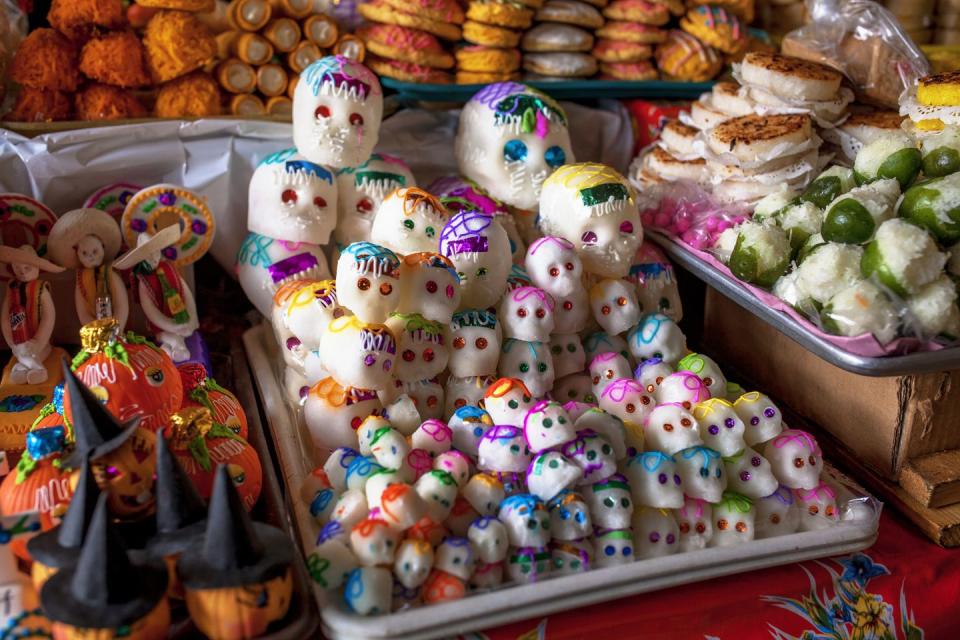
"This tradition is rooted in the native Mexican belief that life on earth is a preparation for the next world, and of the importance of maintaining a strong relationship with the dead," Juan Aguirre, Executive Director of the Mexican culture non-profit Mano a Mano, previously told Oprah Daily.
Visitations from the departed makes Dia de Los Muertos a joyful holiday, with lively and colorful celebrations. "It’s a time to connect with family and loved ones. My family and ancestors have shaped who I am, which is why I honor them on this day," Bri Luna, owner and creative director of The Hoodwitch, tells Oprah Daily.
Even if you’re not living in a place where Dia de Los Muertos parades pass down the streets, there’s a way to celebrate in your own home. Below, Latinx practicioners provide rituals for celebrating the holiday respectfully.
Create an ofrenda.
Ofrendas, or altars, are the cornerstone of many Dia de Los Muertos celebrations. People who celebrate create altars at their homes or near the graves of loved ones. Altars are an important part of respecting and paying homage to the deceased, as it shows that they are always in our thoughts.
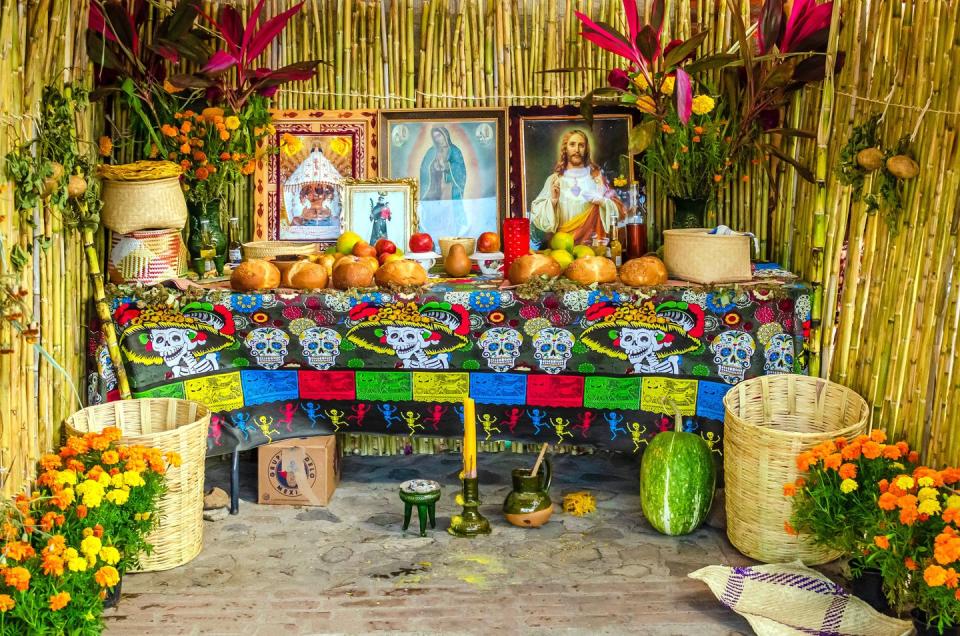
Typically, ofrendas are decorated with photos, chalices, colorful paper cutouts (papel picado), bottles of liquor, candles, water, the deceased’s favorite food, and—most recognizably—marigold flowers. Nicknamed "flowers of the dead" for its prominent place in the holiday celebration, the cempasuchil flower (or Mexican marigold) is said to attract spirits with its sweet scent and bright hue.
Luna has enacted the same Day of the Dead ritual since childhood. “I set up a large altar with my grandmother’s picture, as well as my grandfather’s, stepdad’s, and people who’ve passed away. Then, I place marigold flowers, sweets like pan dulce, skeleton figures, and water to honor the people in my life who are no longer living," Luna says.
Michael Cardenas, a professional witch and owner of Olde Ways, will be honoring his grandmother this holiday. Mama Lola, Cardenas’s grandmother, taught him how to read tarot cards and supported him in his journey into becoming a magical practitioner. He plans to set out tequila and cigarettes, two of her favorite things, on his altar in her honor.
Cleanse the energy of your home.
During Day of the Dead, the border that separates the land of the living and the land of the dead is believed to be thinner than usual. One way to invite your spirits in? Cleanse and prepare your home for their visits. Luna recommends opening up windows and burning copal resin, said to guide the spirits home to their families.
Set out a feast.
Remember, Dia de los Muertos is a celebration of life and the connections that bind us. What better way to feel connected than through a special meal, which also features some of the holiday's quintessential foods?
During their Dia de Los Muertos dinners, most families leave an empty place setting for the departed and cook their favorite foods. “If you are unsure about what your ancestors like to eat, you can prepare what you like,” Cardenas says. "Since they are part of your lineage, it’s safe to say that they will enjoy the same foods as you."
For dessert, set out some cavaleras, which are skulls made out of sugar. Cavaleras are placed on ofrendas and are eaten as a holiday treat.
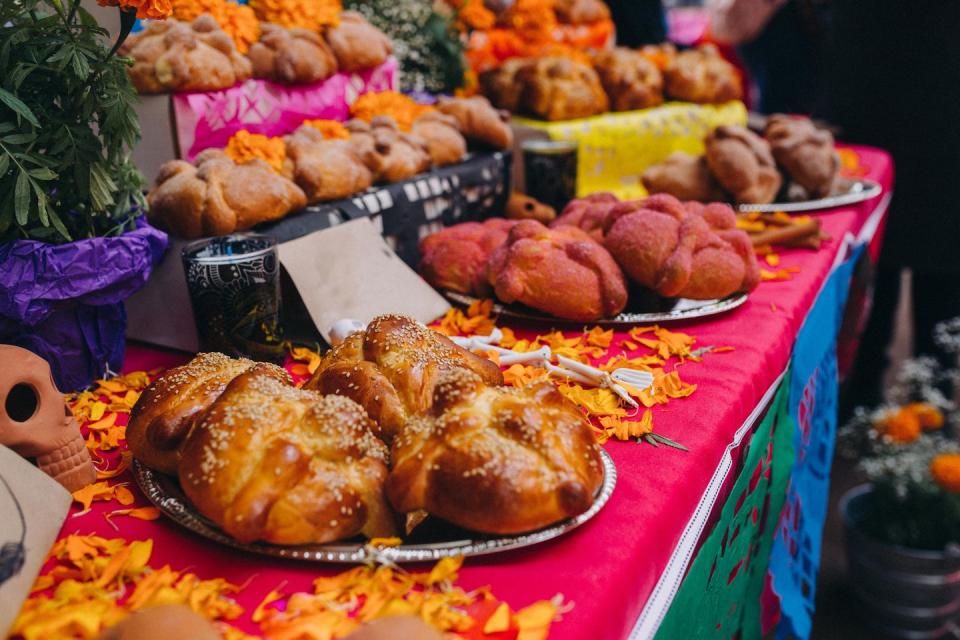
Visit the cemetery.
On Dia de Los Muertos, graveyards become a site of gatherings. “Parties happen within the cemetery," Cardenas recalls. "Some families hire mariachis to play music, and they drink in the graveyard to party with the dead."
If you're superstitious or hesitant about spending time in a cemetery, Cardenas has a recommendation: Leave nine dimes at the gate on your way in or out of the cemetery, to pay respect to the land and avoid "taking ghosts home." Why nine dimes? Cardenas explains that nine is the number associated with the dead and endings, and dimes used to be made with silver, which is said to be a form of energetic protection.
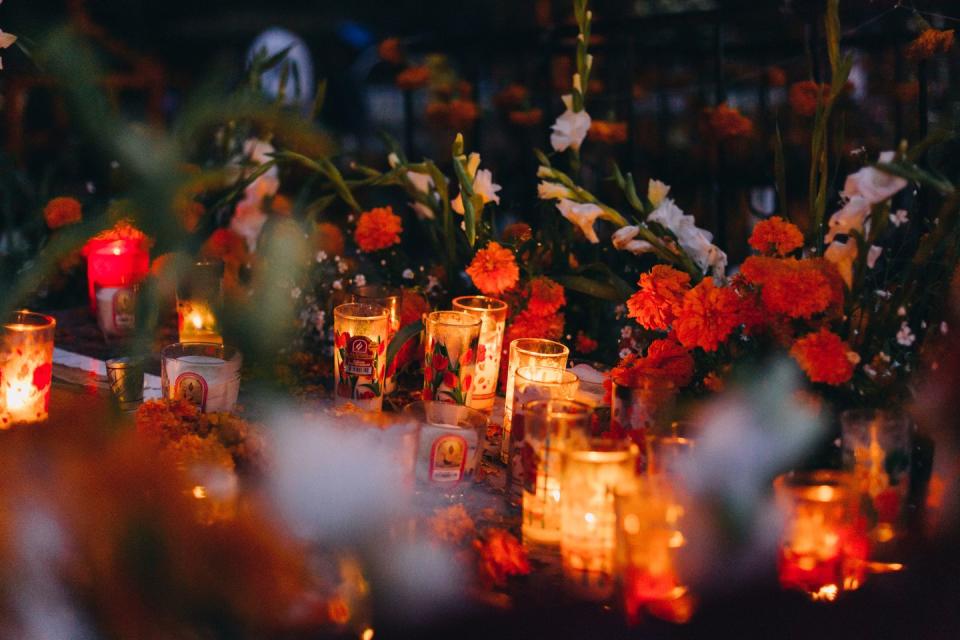
Pass down family stories.
Life coach Arhinna Luciano passes down tales of family members to her children to keep their memory alive. “I use this time to share stories with my daughters about what it was like growing up with their great-grandparents. I also invite them to share stories about my mom,” Luciano says.
This year, she will pay tribute to her family by cooking up some capirotada, a kind of Mexican bread pudding that's one of her mom’s and grandma’s favorite desserts. “We will make this as a family as we listen to Vicente Fernandez and other classics,” she says.
Drink cacao, or hot chocolate.
For all its joyous celebrations, Dia de Los Muertos can be a bittersweet occasion. Luciano adds sweetness to the holiday by making cacao, a hot, chocolatey drink made with cacao paste (though she says a steaming cup of hot chocolate works, too). She and her daughters will add cinnamon to the traditional Mayan beverage to symbolize love and abundance, and vanilla for sweetness.
"The warmth of the cacao is symbolic of us opening hearts as we connect with the earth and all those who were before us," Luciano says, adding that the drink honors her family's Mayan ancestors, too.
Raise a glass to those who came before you.
Connect with the spirits by having a few...spirits. In her city of Oaxaca, Seker says, residents pour mezcal in ofrendas, but she's going to raise a glass of bourbon for her ancestors. After all, Day of the Dead celebrations can be customized to what resonates with you.
Toasting to the lives of the departed may entice them to come back to Earth—but it's definitely a way to remember them. And that's what Dia de Los Muertos is all about.
Want more stories to inspire you to live your best life? Sign up to become an Oprah Insider!
You Might Also Like

